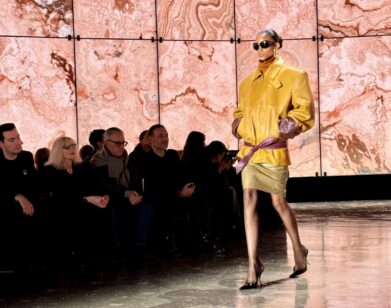Tilda Swinton Enlivens Fashion History
The laws of museum preservation are sacred. Once stored, pieces may never again be touched by human hands—let alone worn.
Reflecting upon this quandary, the Musée Galliera’s curator Olivier Saillard devised The Impossible Wardrobe, a performance piece that has breathed new life into some of the Galliera’s most precious acquisitions. Enlisting the one and only Tilda Swinton as his (not-so) blank canvas, Saillard enthralled audiences in the halls of the Palais De Tokyo across three sold-out evenings during Paris Fashion Week, as part of Festival d’Automne.
Preluding the live event was Katerina Jebb’s film The Future Will Last A Very Long Time, a dreamlike piece in which the artist captured Tilda’s entrance to and discovery of the Musée Galliera’s physical archive space. The eight-minute film combines narrative with montage of new and found footage, from Swinton coveting various garments to historic images of their original owners, from Marie Antoinette to Elsa Schiaparelli.
The Impossible Wardrobe was an exercise in precision and sensuality. Opening Swinton’s one-woman runway show, Saillard himself dramatically unveiled a seven-foot mirror from under brown paper. What followed was a 40-minute sequence of unique passages in which Tilda, dressed in a nude robe and suede pumps, presented various garments and accessories from the annals of European history to a silently expectant crowd. Neutrality (palest skin, hair, dress, and shoes) allowed her to become each character. Each time Swinton reached the mirror, one’s eye was drawn to her reflection—the 3-D dimension of space between the actress and her precious charge melting away in an instant.
Swinton exuded a quiet reverence and curiosity as she returned time after time with a new treasure—each carefully unwrapped from cloth by Saillard and his assistant Alexandre Samson. Unable to wear the pieces on the body, Swinton reveled in her ability to support, showcase, and flirt with the archival garments. From a delicate sniff of Napoleon’s coat to the bustling sway of Chanel suits clasped at the hip, the actress adapted her gait, expression, and poise not only to each piece’s shape and aesthetic quality, but also to their rightful (and often long-dead) owners. The garments themselves told a surreal and glamorous tale—from the Comtesse du Beaumont’s starry Lanvin bathing suit (1924) to Sarah Bernhardt’s extravagant ermine collar. Elsa Schiaparelli’s 1936 claw-tipped evening gloves made an appearance pinned to a calico board, and closing the show were Salvador Dalí’s candy-pink trousers dragged out on a clothes rail—perhaps an abrupt reminder of exactly where these celebrated souvenirs would return.
Whether twirling a pleated Mariano Fortuny Delphos dress suspended from a grosgrain ribbon, swinging a velvet coat like a matador’s cape or staring through the monocle attached to a top hat, Swinton’s sincere theater was addictive. The project proves not only a liberating reminder of fashion as expression (over even commercial concerns), but a riveting glimpse of fashion history in motion.







